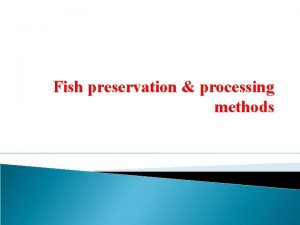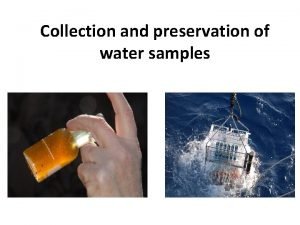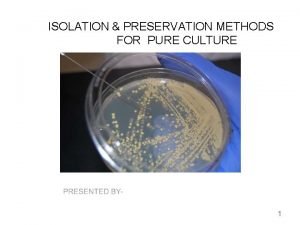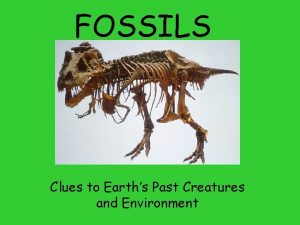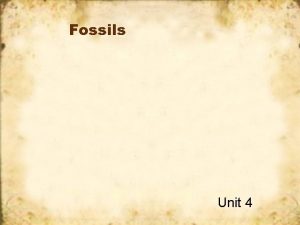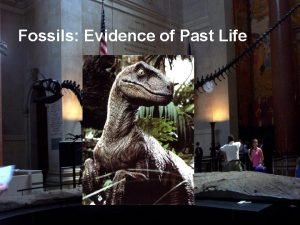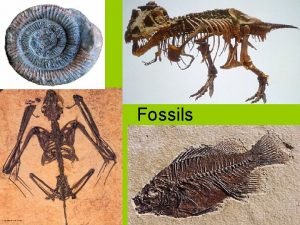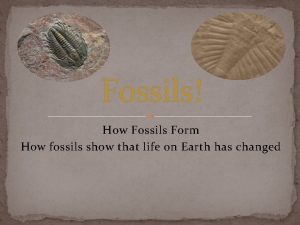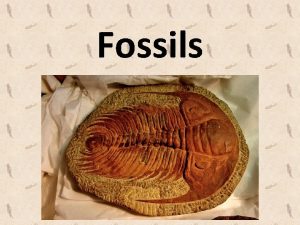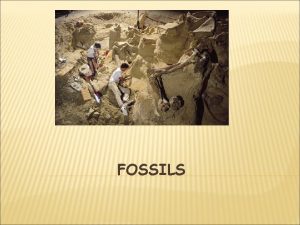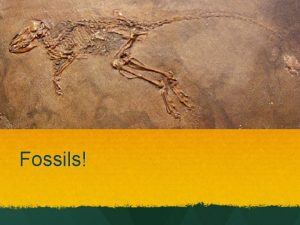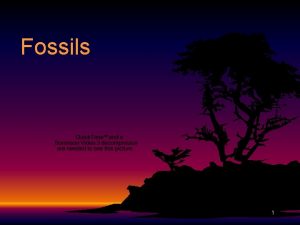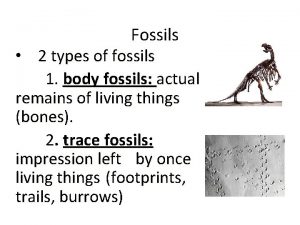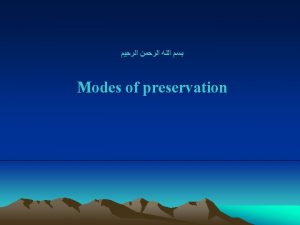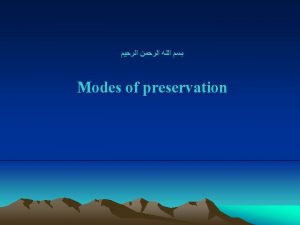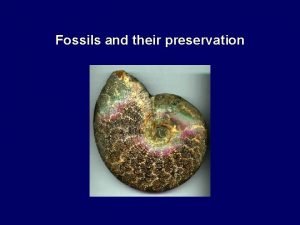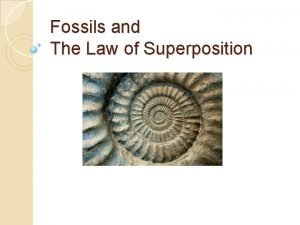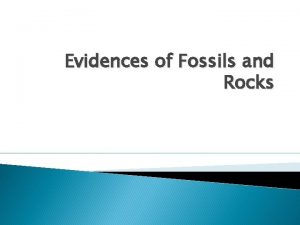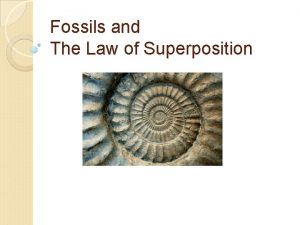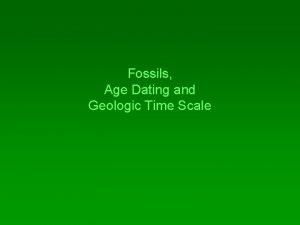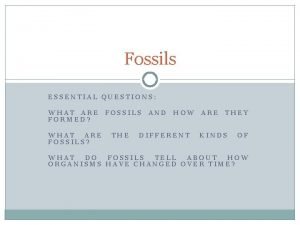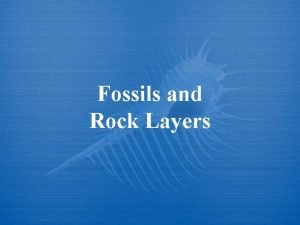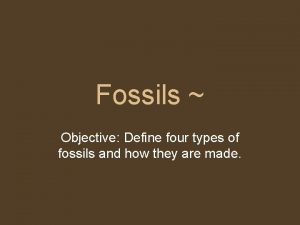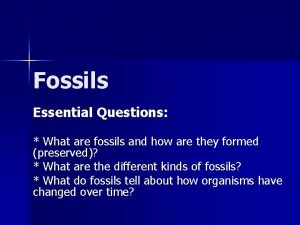The study of fossils Fossils and their preservation





















































- Slides: 53

The study of fossils Fossils and their preservation.

Stratigraphic Column This shows the occurrence of a range of organisms through the Phanerozoic (since 542 million years ago). The beginning of the Cambrian has changed slightly since the leaflet was produced!

William Smith 1769 -1839 William Smith is credited with being the first person to appreciate that fossils could be used to identify particular strata. 2015 was the 200 th anniversary of the publication of William Smith’s map of the geology of England Wales

What are fossils? • The trace of an organism preserved in rock, either the organism itself (body fossils) or the track trail or burrow where the animals have lived (trace fossils). Ammonites, and below trace fossils (Skolithos), the remains of worm tubes in Jurassic rocks at Bowleaze Cove, near Weymouth.

The use of fossils. • They provide information about the evolution of life since the Earth was formed 4. 5 billion years ago – the oldest fossils are around 3 billion years old. Primitive bacteria in existence over 3 billion years ago and less primitive organisms on a geology field trip!

The use of fossils. They tell us about environmental conditions using the Law of Uniformitarianism – the present is the key to the past i. e. we look at modern environments and their organisms and work backwards. Modern coral polyps, corals washed up on a beach in Queensland the Jurassic colonial coral Isastrea from Tisbury in Wiltshire. We assume corals lived in similar conditions in the Jurassic or earlier as now.

Corals from the Silurian and the Carboniferous Wenlock Limestone Favosites from Wenlock Edge, Shropshire Carboniferous Limestone Caninia from Stackpole Quay, Pembrokeshire

Use of fossils continued. • Fossils are also used for dating rocks (relative dating) – some organisms are particularly useful – zone fossils characteristic of a narrow range of age e. g. ammonoids Goniatites typical of the Devonian and Carboniferous, ceratites found in the Permian and Triassic and ammonites in the Jurassic and Cretaceous identified on the basis of the increasing complexity of their suture lines.

Relative dating: Evolutionary trends in fossils. Graptolites • Graptolites are extinct colonial marine organisms that are used for dating rocks in the Ordovician and Silurian periods of the Lower Palaeozoic. The group then became largely extinct.

Relative dating: Evolutionary trends in fossils. Graptolites • The general evolution was from many stipes to one and from simple thecae to complex. The primitive dendroid type on the left and the advanced uniserial monograptids on the right.

Examples of Didymograptus murchisoni from Abereiddi Bay, Pembrokeshire.


Zone fossils: fossils used for dating. • A zone fossil is one that is only found in a narrow • • thickness of strata. The ammonoids and graptolites are good zone fossils which should ideally: evolve quickly. be widespread geographically and independent of facies (environment of deposition). be numerous and easily preserved. be easily recognised.

Good zone fossils and not so good! • Useful: • Ammonoids: goniatites, • Not so useful: • Birds and other • • • ceratites and ammonites. Graptolites. Trilobites in the Cambrian. Corals in the Lower Carboniferous vertebrates Gastropods (snails) Insects Mammals

The main type of organisms • Non-vertebrates with no • • hard parts Invertebrates with a shell or exoskelton Vertebrates with an internal skeleton.

Non-vertebrates • Non-vertebrate fossils are rare because they have no hard parts and are difficult to fossilise. Here we see a fossil jellyfish of late Precambrian age from South Australia from the Edicara Beds.

Invertebrates • Invertebrates have an external shell or test as seen by modern shells found on the beach but are frequently found as fossils. Here we see typical bivalve shells preserved, similar to modern cockle shells.

Vertebrates • These are creatures with an internal skeleton such as fish or reptiles. These are more rarely preserved as fossils but can still be found. An early Tertiary fossil fish

Factors which favour fossilisation • Organisms with hard parts, shells, bones or teeth such as this ichthyosaur. The skull of an ichthyosaur, a marine reptile found in Jurassic rocks.

Factors favouring fossilisation cont. • Rapid burial by • sediment before the organism can be destroyed by predators or scavengers. Cover with fine grained sediment – clay, silt etc. as seen with this Burgess Shale fossil from the Cambrian of British Columbia, Canada.

Factors favouring fossilisation cont. • Low energy conditions so • the remains are not disturbed by waves or currents. Oxygen poor conditions which limits predators / scavengers shown by this Carboniferous leaf from the Coal Measures at Radstock in Somerset. It is preserved in a mudstone sedimentary rock.

Factors favouring fossilisation cont. • These factors will not all occur at the same • time. Rapid cover by sediments normally goes with high energy conditions not favourable for fossil preservation e. g. turbidity flows. Turbidity flows occur on the sea floor often triggered by an earthquake and are rapid flows of water and sediment. However they will normally destroy any organism.

Rock sequence at Welcome Mouth, near Bude, Cornwall. Interbedded mudstone and greywacke sandstone typical of a turbidite sequence with few fossils.

Methods of fossilisation • The original shell often preserved in more recent fossils such as those from the Tertiary. Normally the shell is made of aragonite, a form of calcium carbonate. Some organisms have hard parts made of calcite such as echinoids (sea urchins) as in lower picture.

Gastropods from the Headon Beds, Hordle Cliff, Hampshire

Methods of fossilisation cont. • The original shell recrystallises to calcite. This is achieved by diagenetic changes which affect the rock through time and often involves circulating ground water. Any change in the original mineral is called petrification.

Methods of fossilisation cont. • The original aragonite or calcite can be replaced by other minerals such as quartz and pyrite, in this case an ammonite replaced by pyrite from the Lower Jurassic.

Methods of fossilisation cont. • Sometimes the original shell is dissolved away and leaves a mould which can later be filled with another mineral to form a cast. This is well developed in the Portland Stone Roach with “Portland Screws” and “Osses Eads” where no in -fill has occurred.

Methods of fossilisation cont. • Sometimes rare methods of fossilisation occur such as deep freezing e. g. this baby mammoth from the Siberian tundra where it had been in the permafrost for thousands of years.


Methods of fossilisation cont. • Preservation in amber can also occur often trapping insects and made famous in Jurassic Park! Amber is fossil tree sap and examples are mainly of Tertiary age from the Baltic region and also in the Caribbean.


Methods of fossilisation cont. • Another way in which fossils can be preserved is where animals are trapped in tar pits. Illustration from Prehistoric Life by David Norman, artist’s impresion of La Brea tar pit, Los Angeles

Methods of fossilisation cont. • Despite these unusual methods of preservation, remember that the most common is for the shell of an organism to be covered by sediment in a moderately low energy environment. Fossil crinoids typical of the Jurassic

The fossil record is very incomplete • A very small proportion of • organisms that have lived have been preserved. Soft bodied nonvertebrates are rarely preserved e. g. worms although these may leave trace fossils – traces of where they have been – e. g. at Bowleaze Cove, east of Weymouth. The U shaped burrow of Diplocraterion probably formed by a marine worm similar to a rag worm

A small fraction of 1% of organisms will be fossilised. • Shells may be broken by wave action. Broken shells on a modern beach, few of these will be preserved as fossils.

Slab of Forest Marble with shell debris from the Fleet Shore at the Moonfleet Hotel. This includes echinoid spines, crinoid ossicles, bivalve fragments and bryozoa.

Incomplete fossil record continued • Organisms when they die may be destroyed by • predators / scavengers. They may not be covered by sediment to help preservation. Henry de la Beche Diorama of the Jurassic drawn in 1830 based on fossils found around Lyme Regis

Fossils can be destroyed by natural processes • Weathering and erosion – rock falls at Burton Bradstock.

Another reason for the incomplete fossil record • Rocks can be affected by metamorphism and melting during mountain building events. A deformed trilobite is seen here. Metamorphism recrystallises the rock destroying the original sedimentary and fossil features commonly seen in limestone altered to marble.

Fossiliferous limestone converted into marble Forest Marble from the Fleet shore and Italian marble

Incomplete fossil record continued. • Only part of the organism may be preserved e. g. sharks’ teeth. The skeleton of a shark is made of cartilage and is rarely preserved.

However this can still be useful! • Sea life centre finds 12, 000 SHARKS' TEETH after • • • draining aquarium for first time in 23 years 12, 000 shark teeth found by researchers filtering through sea display gravel Scientists plan to use teeth as part of a probe into global warming Teeth discovered when the tank was emptied for first time in 23 years.

• Sea Life Centre keepers were left stunned when more than 12, 000 shark teeth were discovered hidden in the gravel sea bed after a tank was drained as part of a refurbishment. • Staff at the Blackpool centre were amazed when researchers • • filtering through the bottom of the ocean display pulled out thousands of deadly shark fangs - that had built up over nearly 25 years. Sharks are known to lose one tooth a week on average, but the scale of the find at the aquarium was still surprising to experts. And scientists now plan to use the teeth as part of a probe into global warming - hoping the teeth will enable them to perfect a scientific technique which records ocean temperatures (O 16/18 ratio).

Fossils come in various sizes • This plesiosaur was around 4 -5 metres in length

These micro-fossils are the size of a pin head. Such fossils still have their use telling us about environmental conditions and dating the rocks. These are very useful in the oil industry when found in drilling chips

Some organisms are great survivors Algal Limestone, Assynt, N. W. Scotland, at least 1000 million years old!

Stromatolite in the Durness Limestone, around 500 million years old

Fossil Forest at Lulworth, late Jurassic/ early Cretaceous, around 140 million years old.

Present day stromatolitic limestone Lake Thetis, Western Australia These organisms helped to create our oxygen rich environment!

Reconstructing past environments. Purbeck environment 145 million years ago based on the fossil record including trace fossils) footprints and sedimentary features (ripple marks and desiccation cracks).

Artist’s impression of the edge of the Purbeck lagoon

The Purbeck lagoon fauna.
 Fish preservation and processing
Fish preservation and processing Types of water sampling
Types of water sampling Preservationist apush
Preservationist apush Preservation of cereals
Preservation of cereals Isolation and preservation method for pure culture
Isolation and preservation method for pure culture Cereal spoilage
Cereal spoilage Careful protection and preservation of environment
Careful protection and preservation of environment Romeo and.juliet prologue
Romeo and.juliet prologue Hình ảnh bộ gõ cơ thể búng tay
Hình ảnh bộ gõ cơ thể búng tay Lp html
Lp html Bổ thể
Bổ thể Tỉ lệ cơ thể trẻ em
Tỉ lệ cơ thể trẻ em Voi kéo gỗ như thế nào
Voi kéo gỗ như thế nào Chụp phim tư thế worms-breton
Chụp phim tư thế worms-breton Hát lên người ơi alleluia
Hát lên người ơi alleluia Các môn thể thao bắt đầu bằng tiếng đua
Các môn thể thao bắt đầu bằng tiếng đua Thế nào là hệ số cao nhất
Thế nào là hệ số cao nhất Các châu lục và đại dương trên thế giới
Các châu lục và đại dương trên thế giới Công của trọng lực
Công của trọng lực Trời xanh đây là của chúng ta thể thơ
Trời xanh đây là của chúng ta thể thơ Cách giải mật thư tọa độ
Cách giải mật thư tọa độ Phép trừ bù
Phép trừ bù Phản ứng thế ankan
Phản ứng thế ankan Các châu lục và đại dương trên thế giới
Các châu lục và đại dương trên thế giới Thơ thất ngôn tứ tuyệt đường luật
Thơ thất ngôn tứ tuyệt đường luật Quá trình desamine hóa có thể tạo ra
Quá trình desamine hóa có thể tạo ra Một số thể thơ truyền thống
Một số thể thơ truyền thống Cái miệng xinh xinh thế chỉ nói điều hay thôi
Cái miệng xinh xinh thế chỉ nói điều hay thôi Vẽ hình chiếu vuông góc của vật thể sau
Vẽ hình chiếu vuông góc của vật thể sau Biện pháp chống mỏi cơ
Biện pháp chống mỏi cơ đặc điểm cơ thể của người tối cổ
đặc điểm cơ thể của người tối cổ Thế nào là giọng cùng tên?
Thế nào là giọng cùng tên? Vẽ hình chiếu đứng bằng cạnh của vật thể
Vẽ hình chiếu đứng bằng cạnh của vật thể Vẽ hình chiếu vuông góc của vật thể sau
Vẽ hình chiếu vuông góc của vật thể sau Thẻ vin
Thẻ vin đại từ thay thế
đại từ thay thế điện thế nghỉ
điện thế nghỉ Tư thế ngồi viết
Tư thế ngồi viết Diễn thế sinh thái là
Diễn thế sinh thái là Dot
Dot Các số nguyên tố
Các số nguyên tố Tư thế ngồi viết
Tư thế ngồi viết Lời thề hippocrates
Lời thề hippocrates Thiếu nhi thế giới liên hoan
Thiếu nhi thế giới liên hoan ưu thế lai là gì
ưu thế lai là gì Khi nào hổ mẹ dạy hổ con săn mồi
Khi nào hổ mẹ dạy hổ con săn mồi Khi nào hổ mẹ dạy hổ con săn mồi
Khi nào hổ mẹ dạy hổ con săn mồi Sơ đồ cơ thể người
Sơ đồ cơ thể người Từ ngữ thể hiện lòng nhân hậu
Từ ngữ thể hiện lòng nhân hậu Thế nào là mạng điện lắp đặt kiểu nổi
Thế nào là mạng điện lắp đặt kiểu nổi Critical examination in method study
Critical examination in method study Work study objectives
Work study objectives Distinguish between time study and motion study
Distinguish between time study and motion study Mold fossil
Mold fossil
